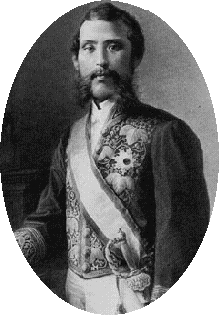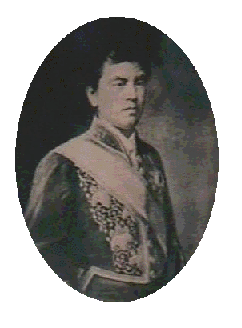 |
 |
| Toshimichi Okubo (1830 - 1878) | Takayoshi Kido (1833 - 1877) |
Top political leaders who most contributed to the Meiji Revolution.
Japans' modernization began with Charter Oath of
Five Articles issued by the Emperor Meiji in 1868.
|
PROFILE OF THE TWO MEN
| OKUBO TOSHIMICHI | KIDO TAKAYOSHI | |
| Date of Birth | 10 September 1830 | 26 June 1833 |
| Place of Birth | Kagoshima, castle town of Satsuma ruled by the Shimazu family. | Hagi, castle town of Choshu ruled by the Mori family. |
| Family | Eldest son of Okubo Yoshiyo, a lower ranking samurai. He has four sisters and no brother. Married to Masuko, a daughter of a Satsuma samurai, having eight sons and one daughter. |
The first (real) son of Wada Masakage, a doctor of the Choshu domain. At age 7, adopted into the Katsura family, a middle ranking samurai. He has three sisters and a brother-in-law, adopted husband of the eldest sister, later the second elder sister. Married to Matsuko or Ikumatsu, an ex-geisha of Kyoto, with no children, but some adopted sons. She helps him much in his hardest time as a wanted man of the bakufu (Tokugawa government) in such a way as giving refuge to him. |
| Other Names | Shosuke, Ichizo pen name: Kotoh |
Katsura Kogoro, Kido Kanji, Kido Junichiro pen name: Shogiku |
Education and other creer |
In his childhood, he practices Zen meditation under Musan-osho, a famous
buddhist priest in Satsuma. Studies Yomei-gaku, the doctrines of Wang Yang-ming, under Ito Moemon, a notably strict Satsuma scholar. Being influenced by Hotoku (his maternal grandfather), a famous Satsuma scholar as well as doctor with Western knowledge. |
At age 9, goes to a reputable private school to learn reading and writing. At age 12, attends Meirin-kan, the official college of the Choshu domain. At age 13, practices Kenjutsu, or Japanese fencing. At age 16, studies militaly tactics under Yoshida Shoin, most revolutionary and influential teacher of young Choshu Imperial Loyalists. At age 19, goes to Edo, the Shogun's capital, to practice Kenjutsu at the Saito Dojo, one of the three famous Kenjutsu schools in Edo, and appointed the head of the pupils in a year. At age 20, studies Western military tactics at the school of Egawa Tarozaemon, a magistrate of the bakufu. At age 22, studies shipbuilding and Dutch learning. |
| Main Career since 1868 |
Councilor of State, Minister of Finance, Minister of Home Affairs (as the
last title) Deputy-Ambassador of the Iwakura Mission in 1871 |
Councilor of State, Minister of Education, Chairman of the Governors' Conference,
Adviser to the Cabinet (as the last title) Deputy-Ambassador of the Iwakura Mission in 1871 |
| Political Stance and Objectives | Conservative. To establish national rights and stability under the imperial authority. Any reform should be given careful consideration and no need to hurry. |
Liberal. To establish an imperial state with constitution and civil rights. Separation of the three government powers should be implemented as soon as possible. |
| Personal Character | indomitable, cool, grim, powerful, responsible |
faithful, affectionate, innovative, thoughtful, delicate |
| Interest | The game of "go" next to politics. |
He is a man of many tastes such as painting, writing, drinking, etc. |
| Date of Death | Assassinated on 14 May 1878 | Dies of a desease on 26 May 1877 |
| Remarks | Some historians criticize him for his coldness in treating opponents of
the government and regard him as a despotist. Others consider him the great
and competent prime minister in the cradle of the Meiji government. Either
estimation seems to reflect some truth. |
The leader of radical anti-shogunate revolutionalists gave way to Okubo's
policy gradually after the Meiji Restoration because of his poor health
and inclination for peace. However, his pride finally made him leave the
government. Then Okubo's chase for him began. |
CHRONOLOGY
History of Japan I (660B.C. - 1600A.D.)
History of Japan II (1600A.D. - 1912A.D.)
Japanese site